
Sunday, April 23, 2006
Rutland - Easter 2006
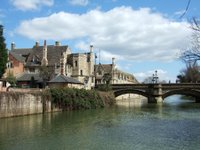 Rutland Water is the largest man made lake in Western Europe, and a very pleasant place for a sunny spring day. We spent a relaxing afternoon on Good Friday by the lake after a walk from Stamford to Ryall.
Rutland Water is the largest man made lake in Western Europe, and a very pleasant place for a sunny spring day. We spent a relaxing afternoon on Good Friday by the lake after a walk from Stamford to Ryall.Stamford is a very beautiful stone town, used for all the town & village scenes in the latest production of Pride & Prejudice. The town escaped the industrial revolution because the family at the nearby great house of Burghley House refused to let the rail-way come & spoil 'their' town. This was probably an economical blow to the tradesmen of the time, but a bonus for the current tradesmen.
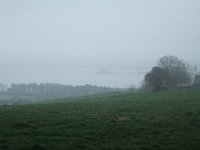 Easter Saturday started very misty & we walked from the picturesque town of Lyddington past another reservoir, used by the Lancaster bombers in WWII to practice night time bombing. We then visited the Bede House in Lyddington, originally a Bishop's Palace, stayed in by Henry 8th, later an Almshouse. A tour of the accommodation made us less than enthusiastic to have been a resident!
Easter Saturday started very misty & we walked from the picturesque town of Lyddington past another reservoir, used by the Lancaster bombers in WWII to practice night time bombing. We then visited the Bede House in Lyddington, originally a Bishop's Palace, stayed in by Henry 8th, later an Almshouse. A tour of the accommodation made us less than enthusiastic to have been a resident!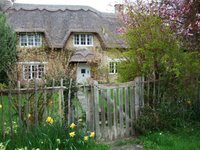 We then did a very interesting guided walking tour of Stamford, followed by a circular walk around Exton described as one of the loveliest villages in Rutland. It is certainly rates as one of the best we have visited.
We then did a very interesting guided walking tour of Stamford, followed by a circular walk around Exton described as one of the loveliest villages in Rutland. It is certainly rates as one of the best we have visited. 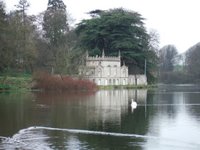 The walk went from the estate village to a folly known as Fort Henry; built in 1788 by William Legg for Henry, Earl of Gainsborough the owner of Exton Park.
The walk went from the estate village to a folly known as Fort Henry; built in 1788 by William Legg for Henry, Earl of Gainsborough the owner of Exton Park.Sunday was lovely and sunny again. We did a morning walk around Belton-in-Rutland, and spent the afternoon visiting two country homes. The first, Deene Park, has a beautiful position, with gracious rooms opening onto a terrace leading to formal gardens with a lake beyond. It is still a beautiful home, obviously much loved by the current family. The second, Southwick Hall, was
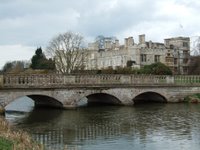 two centuries older and consequently less comfortable, but obviously has had an interesting past.
two centuries older and consequently less comfortable, but obviously has had an interesting past.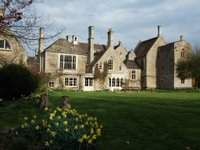
We finished the day with a walk around Oundle, smaller than Stamford, but equally attractive. From there, we did a short walk to Ashton, a delightful village of thatched stone houses, rebuilt by the Rothschild family just over a hundred years ago. We had a lovely dinner in their equally beautiful thatched pub.

Easter Monday started with brilliant sunshine. We started the day visiting Hallaton, which has a fascinating Easter Monday tradition. First they share a hare pie & then compete with a near-by village in a 'bottle-kicking' competition. The 'bottles' are actually small casks of beer. We were too early for the action, so left to visit Grimsthorpe Castle. On the way we passed through Oakham and visited the castle. All that is left is the Great Hall, built 1190, the earliest surviving aisled stone hall in the country.
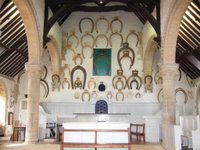 They have a tradition that visiting peers of the realm and royalty must present the Lord of the Manor with a horseshoe. The oldest to survive was presented by Edward IV in 1470 & the most recent by Princess Alexandra in 2005. The “horseshoes” are horseshoes in shape only, rather large and grandiose, depending on the donor.
They have a tradition that visiting peers of the realm and royalty must present the Lord of the Manor with a horseshoe. The oldest to survive was presented by Edward IV in 1470 & the most recent by Princess Alexandra in 2005. The “horseshoes” are horseshoes in shape only, rather large and grandiose, depending on the donor.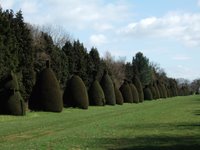 The next interesting place we stumbled over was a topiary by Clipsham, an amazing driveway to Clipsham Hall, now looked after by the Forestry Commission.
The next interesting place we stumbled over was a topiary by Clipsham, an amazing driveway to Clipsham Hall, now looked after by the Forestry Commission.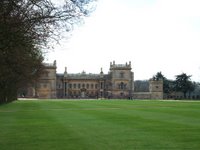 Grimsthorpe Castle, when we reached it, was most impressive and interesting. The family has the hereditary office of Lord Great Chamberlain. This means they have a collection of thrones from the House of Lords, used by previous monarchs.
Grimsthorpe Castle, when we reached it, was most impressive and interesting. The family has the hereditary office of Lord Great Chamberlain. This means they have a collection of thrones from the House of Lords, used by previous monarchs.The sun had been replaced by thunder storms by the time we left Grimsthorpe, and by the time we reached our final destination of Rockingham Castle, there was a terrific hail storm.
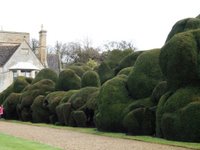 Rockingham Castle is 900 years old, and would have withstood many such storms and much worse over the centuries. For half of that period it was a royal fortress and the remaining 450 years a family home. An excellent video captured the sense of history very cleverly. The castle gave us a feeling of the past, but we enjoyed the grounds and the amazing view over the countryside more.
Rockingham Castle is 900 years old, and would have withstood many such storms and much worse over the centuries. For half of that period it was a royal fortress and the remaining 450 years a family home. An excellent video captured the sense of history very cleverly. The castle gave us a feeling of the past, but we enjoyed the grounds and the amazing view over the countryside more.Bank holiday traffic never ceases to amaze us, and we returned to London in less than 2 hours.
Wednesday, April 12, 2006
Newbury - 8 & 9 April 2006
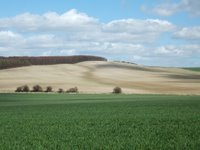 The Ridgeway is one of the many long distance footpaths in Britain. We explored a small section of it in glorious sunshine, the day before the south was once again unseasonably covered in snow.
The Ridgeway is one of the many long distance footpaths in Britain. We explored a small section of it in glorious sunshine, the day before the south was once again unseasonably covered in snow.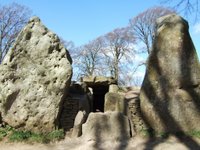 Typical vistas are of large fields and a gently rolling landscape. Along the way we came across one of many burial barrows in the UK, Waylands Smithy. This one had already been looted when excavated in 1920. Further along the Ridgeway was one of the most stylised White Horses we've seen here. They also date from 1000BC and are stunning on the green hills, the shape revealing the horse in the white chalk beneath.
Typical vistas are of large fields and a gently rolling landscape. Along the way we came across one of many burial barrows in the UK, Waylands Smithy. This one had already been looted when excavated in 1920. Further along the Ridgeway was one of the most stylised White Horses we've seen here. They also date from 1000BC and are stunning on the green hills, the shape revealing the horse in the white chalk beneath.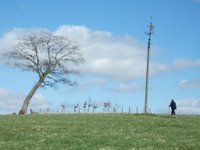 For the Kiwis, we found a replacement tree and obelisk for One Tree Hill!
For the Kiwis, we found a replacement tree and obelisk for One Tree Hill!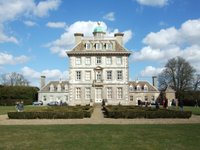 The walk also included Ashdown House, built 1663 in a Dutch style for a sister of Charles I. The house contains her collection of family portraits. The amazing feature of the house is the huge wooden staircase that occupies 25% of the floor area of the building.
The walk also included Ashdown House, built 1663 in a Dutch style for a sister of Charles I. The house contains her collection of family portraits. The amazing feature of the house is the huge wooden staircase that occupies 25% of the floor area of the building.In spite of the recent discovery of bird-flu in the swan up north, we dined in the Swan down south. The staff at our accommodation made the recommendation, not difficult in a country teeming with picturesque pubs serving tasty food.
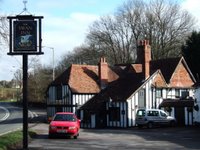
The Sunday weather forecast was for rain mid-afternoon, so we set out for a morning walk to beat the weather. The walk included several small Berkshire villages. We lunched at the final village - Brimpton Common in a pub called The Pineapple. Unlike our understanding of pineapples these days, the name refers to the fruit of a pine tree, which we know as a pine- cone. When pineapples did arrive here, they were exotic and only enjoyed by the rich. Not likely to be served at a pub.
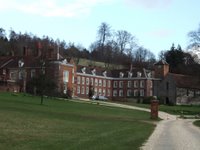 We decided the rain wasn't about to arrive for a while and drove in lovely sunshine to look at Stonor House. By the time we parked, the sky had darkened & we just made it inside before the hail made it extremely cold and unpleasant. The house had an interesting history, as they all do! We saw a priest hole where, during the reign of Elizabeth I, a printing press was secreted in the roof space to publish Catholic literature. The printer was Edmund Campion: captured in 1581; sent to the Tower; tried then hung, drawn & quartered (nasty habit they had). In 1970 the Catholic Church made him a saint.
We decided the rain wasn't about to arrive for a while and drove in lovely sunshine to look at Stonor House. By the time we parked, the sky had darkened & we just made it inside before the hail made it extremely cold and unpleasant. The house had an interesting history, as they all do! We saw a priest hole where, during the reign of Elizabeth I, a printing press was secreted in the roof space to publish Catholic literature. The printer was Edmund Campion: captured in 1581; sent to the Tower; tried then hung, drawn & quartered (nasty habit they had). In 1970 the Catholic Church made him a saint.
Monday, April 03, 2006
Kent - 1 & 2 April 2006
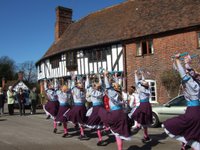 Kent in the spring proved to be a very interesting weekend. We started at Chilham, a village that is reportedly the most photographed village in England, and has been used in films (Moll Flanders) and TV series such as Miss Marple.
Kent in the spring proved to be a very interesting weekend. We started at Chilham, a village that is reportedly the most photographed village in England, and has been used in films (Moll Flanders) and TV series such as Miss Marple. 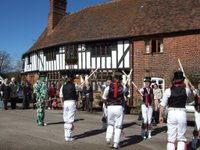
As we had a cup of tea in the very quaint tea-rooms, we watched with interest as people in unusual costumes kept arriving. We seemed to have picked a good day to visit, as they had displays of Morris dancing. We gathered that 1 April was a significant date in the Morris dancer calendar. (There were male groups and female groups. What does one call female Morris Men?)
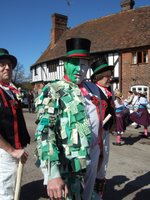 The leader of the Morris dancers had his face painted half green & half white to represent spring chasing winter away.
The leader of the Morris dancers had his face painted half green & half white to represent spring chasing winter away.Lunch was a bowl of absolutely delicious, home made, parsnip apple & curry soup cooked by Lady Fitzwalter of Goodnestone, whose garden we visited.
Suitably refuelled we enjoyed a relaxing walk from Sandwich to the coast and back. Sandwich has a prestigious past as one of the original Cinque Ports and remains a very picturesque town, somewhat larger than Chilham.
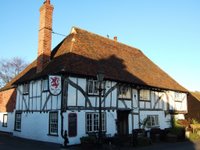 Finally, we then visited two more picturesque villages - Elham & Hernhill, where we had an excellent dinner at a pub with the most popular name in England.
Finally, we then visited two more picturesque villages - Elham & Hernhill, where we had an excellent dinner at a pub with the most popular name in England.Sunday started with a visit to the St Augustine Abbey, part of the Canterbury UNESCO World Heritage site, which also includes the Cathedral and St Martin’s church – the oldest parish church in England.
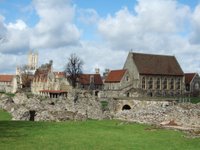 St Augustine was sent by Pope Gregory to re-establish Christianity in Britain. He was granted land to build an Abbey, of which only very small sections of ruins are left. Most of the visible remains are from the later (Norman) buildings.
St Augustine was sent by Pope Gregory to re-establish Christianity in Britain. He was granted land to build an Abbey, of which only very small sections of ruins are left. Most of the visible remains are from the later (Norman) buildings.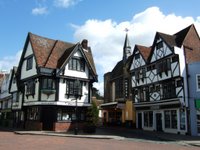 Next stop was nearby Faversham, another old Cinque Port, and also a beautiful town, with over 500 listed buildings.
Next stop was nearby Faversham, another old Cinque Port, and also a beautiful town, with over 500 listed buildings.The season for visiting stately homes seems to have arrived with April, so we had a relaxing afternoon strolling around the lovely grounds of Belmont House.
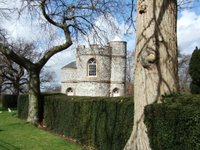 They will be stunning in the summer. We found the brilliant use of espalia type fruit trees very intriguing. This was the first time we had seen apples trained on such low wires, a system is called “step over” for quite obvious reasons. The conducted tour of the house gave a real insight into its history and furnished us with heaps of useless horological trivia as the penultimate resident Lord Harris amassed the world’s largest private clock collection.
They will be stunning in the summer. We found the brilliant use of espalia type fruit trees very intriguing. This was the first time we had seen apples trained on such low wires, a system is called “step over” for quite obvious reasons. The conducted tour of the house gave a real insight into its history and furnished us with heaps of useless horological trivia as the penultimate resident Lord Harris amassed the world’s largest private clock collection.
Monday, March 27, 2006
Winchcombe - 25/26 March 2006
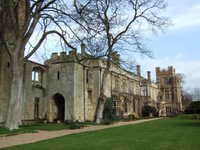 Winchcombe was once the capital of Mercia, and remains a very interesting town, full of beautiful buildings. There are many old pubs, cute rows of houses, and a splendid church.
Winchcombe was once the capital of Mercia, and remains a very interesting town, full of beautiful buildings. There are many old pubs, cute rows of houses, and a splendid church.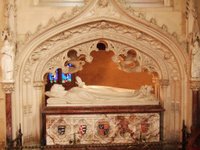 Just outside the town is Sudeley Castle, which has an interesting history itself. It was once the home of Katherine Parr, the last of Henry VIII's wives. She lived there after her second marriage to Thomas Seymour, and is buried there following her early death after childbirth.
Just outside the town is Sudeley Castle, which has an interesting history itself. It was once the home of Katherine Parr, the last of Henry VIII's wives. She lived there after her second marriage to Thomas Seymour, and is buried there following her early death after childbirth.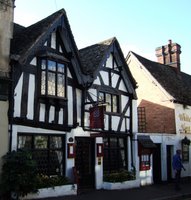 We stayed two nights at the White Hart, a quaint old 16th century inn, right next door to the house John Wesley stayed at for two nights in the 1770s. As well as exploring the town and the castle, we did a walk from the town to Hailes Abbey and back through the tiny hamlet of Farmcote and the even smaller Little Farmcote. Farmcote had a small church, complete with what must definitely be the smallest church cross in Christendom.
We stayed two nights at the White Hart, a quaint old 16th century inn, right next door to the house John Wesley stayed at for two nights in the 1770s. As well as exploring the town and the castle, we did a walk from the town to Hailes Abbey and back through the tiny hamlet of Farmcote and the even smaller Little Farmcote. Farmcote had a small church, complete with what must definitely be the smallest church cross in Christendom. 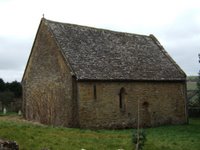 Despite being so small, the church still had a lovely marble tomb inside.
Despite being so small, the church still had a lovely marble tomb inside.On the way home on Sunday, we visited two picturesque villages.
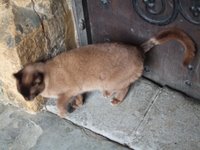 The first was Ilmington. On our walk, we visited the local church that has carved, in various places throughout, 11 mice. They are most entertaining, and a neighbourhood cat posed very thoughtfully for us to take a photograph of one, on the door post.
The first was Ilmington. On our walk, we visited the local church that has carved, in various places throughout, 11 mice. They are most entertaining, and a neighbourhood cat posed very thoughtfully for us to take a photograph of one, on the door post.The second village of Warmington was reached just as the rain was starting, so we left a proper exploration to the next time we are in the area.

Image produced from the Ordnance Survey Get-a-map service. Image reproduced with kind permission of Ordnance Survey and Ordnance Survey of Northern Ireland.
Monday, March 20, 2006
Hampshire - 18/19 March 2006
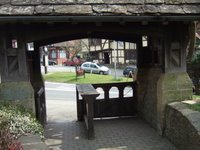 En route to our Saturday walk we stopped of in the delightful village of Chiddingford. The info said it had a rare high coffin rest in the church lych-gate and that coffin rests were the original reason for the covered lych-gates that are such an attractive feature of English country churches. However, it did not say why.
En route to our Saturday walk we stopped of in the delightful village of Chiddingford. The info said it had a rare high coffin rest in the church lych-gate and that coffin rests were the original reason for the covered lych-gates that are such an attractive feature of English country churches. However, it did not say why.  Fortunately the web tells all and it seems that back in the days when the dead may have had to have been carried a reasonable distance to the church, the pallbearers placed the coffin on the coffin rest and sat on the benches either side of the lych-gate to regain their breath and composure before carrying the departed into the church with due decorum. After all, it would not do for the pallbearers to be huffing and puffing up the aisle. Neither would they want to arrive all wet and bedraggled, hence the roof over the lych-gate.
Fortunately the web tells all and it seems that back in the days when the dead may have had to have been carried a reasonable distance to the church, the pallbearers placed the coffin on the coffin rest and sat on the benches either side of the lych-gate to regain their breath and composure before carrying the departed into the church with due decorum. After all, it would not do for the pallbearers to be huffing and puffing up the aisle. Neither would they want to arrive all wet and bedraggled, hence the roof over the lych-gate. Having seen our first coffin rest, we went for a walk from Cowdray Park to Lickfold and back again.
Having seen our first coffin rest, we went for a walk from Cowdray Park to Lickfold and back again. Sunday’s village of note was Selborne where the attraction was a zig-zag path cut by naturalist Gilbert White up the steep escarpment, Selborne Hanger, behind the village. The 29 switchbacks allowed us to climb quickly for sweeping views over the village and surrounds.
Sunday’s village of note was Selborne where the attraction was a zig-zag path cut by naturalist Gilbert White up the steep escarpment, Selborne Hanger, behind the village. The 29 switchbacks allowed us to climb quickly for sweeping views over the village and surrounds.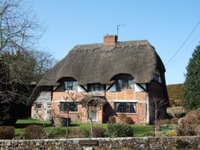 We then motored a little way north to Oakhanger and walked from there to Wyck and back. As we returned to Oakhanger we passed a couple of cottages that were among the best we have seen in terms of embodying all that is quintessentially olde English cottage architecture.
We then motored a little way north to Oakhanger and walked from there to Wyck and back. As we returned to Oakhanger we passed a couple of cottages that were among the best we have seen in terms of embodying all that is quintessentially olde English cottage architecture.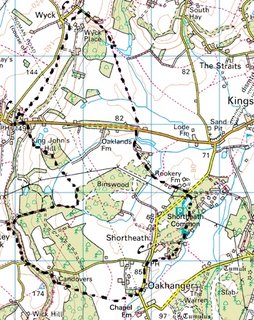
Image produced from the Ordnance Survey Get-a-map service. Image reproduced with kind permission of Ordnance Survey and Ordnance Survey of Northern Ireland.
Sunday, March 12, 2006
Wales - 11/12 March 2006
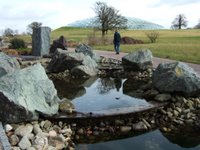 Our weekend trips away have begun now that winter has been declared ‘officially finished’. So, we set off to visit the National Botanical Gardens of Wales, naturally, this entailed a trip to Wales. The gardens were only opened in 2000 and so still need some time to develop and mature but nevertheless were worth the visit and will merit a return visit in the summer when more plants are at their best.
Our weekend trips away have begun now that winter has been declared ‘officially finished’. So, we set off to visit the National Botanical Gardens of Wales, naturally, this entailed a trip to Wales. The gardens were only opened in 2000 and so still need some time to develop and mature but nevertheless were worth the visit and will merit a return visit in the summer when more plants are at their best. 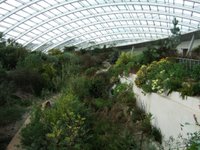
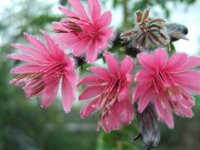 The glasshouse (biggest single span glasshouse in the world) is visually stunning both inside and out.
The glasshouse (biggest single span glasshouse in the world) is visually stunning both inside and out.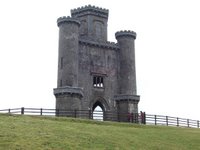 The gardens are on the site of a ‘great house’ (burnt down in 1931) owned in 1700’s by William Paxton, who also built a tower overlooking the area so it was the tower we visited next.
The gardens are on the site of a ‘great house’ (burnt down in 1931) owned in 1700’s by William Paxton, who also built a tower overlooking the area so it was the tower we visited next. 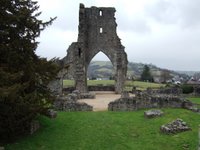
After checking in to our accommodation we cast about on the map and saw an Abbey not far away so set out to visit Talley Abbey, passing through an attractive town, Llandeilo.
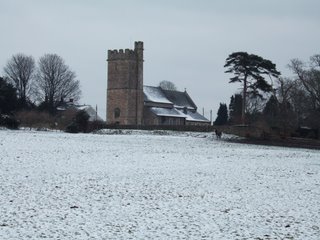
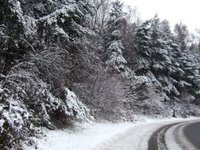 The weather forecast indicated that there would be overnight snow in the area of Wales that we would be journeying through to return to London. As we neared Cardiff it was indeed an attractive vista along the motorway sides. Having visited Castell Coch previously we suspected that is would look good with a dusting of snow so detoured off the motorway to check it out.
The weather forecast indicated that there would be overnight snow in the area of Wales that we would be journeying through to return to London. As we neared Cardiff it was indeed an attractive vista along the motorway sides. Having visited Castell Coch previously we suspected that is would look good with a dusting of snow so detoured off the motorway to check it out. 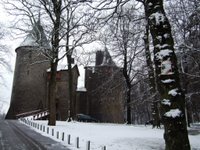
The next detour off our homeward route was to Caerwent, an ancient Roman town where the remains of the Roman walls still encircle most of the village, in places up to 5m high.
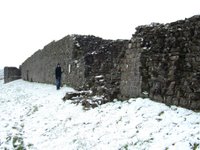 We walked around the walls and then visited the church porch where, in a example of modern ecumenicalism, there is displayed a Roman altar to the god Mars Ocelus originally erected by one Aelius Augustinus who ‘willingly and deservedly fulfilled his vow.’
We walked around the walls and then visited the church porch where, in a example of modern ecumenicalism, there is displayed a Roman altar to the god Mars Ocelus originally erected by one Aelius Augustinus who ‘willingly and deservedly fulfilled his vow.’ 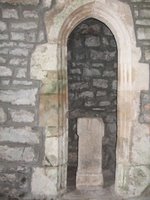
By the time we reached the Severn River there was no evidence of a snow to be seen. However, the snow we did enjoy was the tail-end of a storm which caused havoc in Scotland and the north of England so perhaps our official declaration of winter’s end was a little premature.
Subscribe to:
Comments (Atom)



